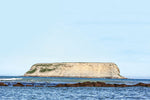
Motunau Beach – A Guide to Fishing & Angler Etiquette
, by NZDiver Admin, 6 min reading time

, by NZDiver Admin, 6 min reading time
Fishing boat crossing the bar at Motunau.
The bar at Motunau is typically navigable for the average trailer boat 1½ to 2½ hours either side of high tide. Most fishermen prefer to head out around high tide and return within that window. If the tide’s too early, some opt to leave on the outgoing tide and return about eight hours later on the incoming.
Either way, make sure you’ve got enough water under the keel for a safe and enjoyable trip.
As with any ramp, use the staging area to get your boat ready. No one likes waiting while someone fiddles about blocking access.
Avoid:
Occupying the center of the two-lane slipway.
Diagonal launching.
Launching unprepared.
Pro tip: Watch other boats launch to see how they navigate the channel and identify shallow spots, especially near the breakwater. A low tide recce is highly recommended if you’re new to Motunau.
Some say the most dangerous bar at Motunau is the one at the Greta Valley Pub—but that’s a different story.
There are two main ways to cross the bar:
Comfortably planing – Get on the plane before you pass the old wharf.
Slow and steady – Trim the motor up and idle carefully.
Planing gives you more control and minimizes time in the danger zone—but beware of low water. If disaster strikes (e.g., fuel line fails), it’s safer to jump overboard and hold the bow into the waves than to risk capsizing.
Once past the surf zone, look back and line up your return course using shore markers.
Motunau’s reefs offer excellent fishing:
🎣 Blue Cod, Moki, Trumpeter, Groper, Kingfish, Butterfish, Salmon, John Dory, Sharks, and even Crayfish.
Try near other boats (but not too close).
Use your depth sounder to find foul ground and cray floats.
Do NOT tie up to a cray float. You’ll likely drag and snag the pot, losing gear (and goodwill).
Instead, tie a float to your anchor warp. This allows:
Quick releases (great if you need to grab divers fast).
Easy returns to a hot fishing spot.
Use large hooks (6/0 and up) to help avoid undersized fish.
Recurve/Kahle hooks are great for clean corner-of-mouth hook-ups.
Flatten treble barbs on jigs for easier releases.
Kill and chill your keepers quickly.
Stick to the Blue Cod Limit of 2 per person
Crays are plentiful at Motunau, and you should be able to bag your limit on a single tank.
Most are female, and in berry from late March to early November. These are off-limits.
In summer, taking barren females is acceptable due to population imbalance.
Look for:
Flat tails = usually male.
Tucked tails = egg-carrying females.
During October–November, check carefully under the pleopods (flaps) for residual eggs.
Plan ahead to allow for:
Raising anchor delays.
Changing sea conditions.
When returning:
Approach on the back of a wave.
High tide = hidden breakwater, less protection but more water.
Low tide = more visible breakwater, more protection but shallower water.
Double-check your channel markers and watch for commercial fishers—they need a longer run-up and can't easily stop. Let them through first.
Fisheries Officers often inspect catches and collect data—this supports sustainable fishing and helps manage the local stocks.
Also: 🎁 Pop a donation in the box near the ramp.
Ramp and bar maintenance isn’t cheap, and that coin helps keep the facility open for all of us.
Use the Rule of Twelfths to estimate water depth changes between tides.
Example for a 2.3m tide:
1 hour before/after high tide = ~2.1m
2 hours before/after = ~1.7m
Half tide = ~1.1m
Important: If you're 10 minutes late coming back 2 hours after high tide, expect the water to be 4 inches shallower.
Motunau Beach lies at the northern tip of Pegasus Bay, about an hour north of Christchurch. Its rocky coast, loaded with fish and crays, draws crowds of anglers and divers every weekend. If you haven’t been—you’re missing out.




